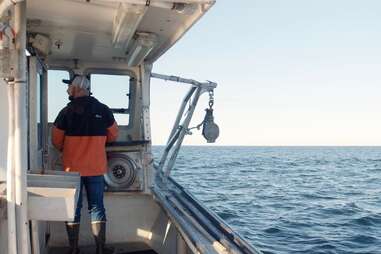A Day in the Life of a Maine Lobsterman
Early mornings and strenuous work bring lobster from the floor of the Atlantic to your plate.
The next time you snooze your alarm clock at a very modest 8 am, think of Mike Sargent. Before you pour your first cup of coffee in the morning or maybe even get out of bed, this fourth-generation lobsterman has already traveled at least a dozen miles off the shore of Steuben, Maine and hauled in a few hundred pounds of lobster.
As one of the lobstermen powering the state’s $1 billion lobstering industry, Sargent works sunup to sundown to bring this seafood delicacy to people across the country. The fisherman has 800 traps—the maximum a commercial fisherman can own in the state of Maine—covering the ocean floor where he collects lobster about five or six days a week in the summer months.
Like most Maine fishermen, Sargent says he was “kind of born into it.” He got a student lobstering license at the age of 10 and started fishing with his dad, and ever since, Sargent has spent summers on the water while others were feasting on lobster dressed up on rolls and boiled at backyard parties. He does manage to sneak in a few lobster feasts here and there. “We’'ll have big family clambakes and I probably eat it three or four times throughout the summer,” Sargent says, but adds that some of his fellow fisherman refuse to eat lobster because they’re surrounded by it day in and day out.

The days are long and the work is taxing, but after a year rocked by COVID-19 and uncertainty about the demand for lobster and the ability to go fishing, lobstermen like Sargent are grateful for a busy summer. “[Last year] was gnarly,” Sargent says. “A lot of people don’t realize, for all of us in these Northern communities, fishing is the lifeblood of this town. If I’m successful, the entire town is successful.”
But it goes beyond that. For most, their relationship with lobster starts with cracking open the first claw and ends with crumbling up a plastic bib after the last bite, but there’s a lot of hard work that goes into fishing for Maine’s defining crustacean. “A lot of people think it’s like Deadliest Catch,” Sargent says with a laugh. But his days are very different from the high-stakes drama of a reality show. Learn about what it takes to bring lobster from the bottom of the Atlantic Ocean to your plate with a day in the life of Sargent, in his own words:
3 am: I’ll get up and check the weather forecast. I’ll check the marine buoy data, see if there’s any inclement weather coming or going. If we’re all good to go, I will message my crew, say, “Yep, we’re set to go today.” They’re usually up and at ’em anyway, so I have them on standby. And then, I pack my lunch and head to the wharf.
4 am: I meet my crew down at the wharf, where I keep my boat. And then we will board the boat, sail off, and do our thing. I fish out of Dyers Bay in Steuben, Maine. It is probably about an hour east of Bar Harbor. It’s a little coastal village. We don’t even have a drugstore in this little town, so it’s a tiny place where lobstering is pretty much the only thing that keeps it going. It takes about an hour to sail out to where my traps are set, because I fish about 12 to 20 miles offshore.
Around 5 am: There’s a legal hauling time that you have to keep an eye on, that’s the legal point when I can use my gaff to pick up the first buoy and start bringing traps aboard. The legal hauling time in Maine in the summer is 30 minutes before sunrise, so we watch the clock and right at that point, we turn the hauling handle and we go to work.
Midday: Most of the time, I do 400 traps a day. We use what’s called strings of traps. I have two traps attached to one line going to the surface with a buoy on it. And then, I put groups of 10 of those in a straight line, we call that a string. We haul one buoy up at a time, and the two traps come aboard the boat. We will rebait them when they come aboard, take all the lobsters out, and measure them. We measure each lobster from the eye socket to the base of the tail—the minimum size is 3¼ inches and the maximum is 5 inches.
Maine is one of the only states that has an undersized and oversized measure, and anything that is outside of those measurements gets thrown back, along with egg-bearing lobsters that we throw back to allow to breed every year. I really think we have the best, most sustainable lobster fishery in the Atlantic Ocean, and we continue to reap those rewards. There are a lot of sharp rocks down there, things get broken here or there, so I like to give the traps a quick glance. If it’s all good to go, we'll set the trap right back out and circle around, and then go to the next one and just continue doing that same routine over and over and over.
Around 4 pm: I step aboard the boat at four o’clock in the morning. And generally, I don't get off my boat until four or five o’clock in the evening. We definitely put our time in and there’s no 40-hour week with this.
5 pm: I sail all the way back home and pull up along the wharf. And actually, it’s owned by my uncle, and he’s the buyer. So I will hoist up all the lobsters we catch and we put them into 100-pound crates, it’s like a plastic tote that floats. We stack them in there. We put about 100 pounds in each one. And we’ll hoist it down to the wharf, and then weigh it. My uncle will write us a slip for what we caught that day. Then we pick up whatever bait and fuel that I need for the next day, and that’s that.

